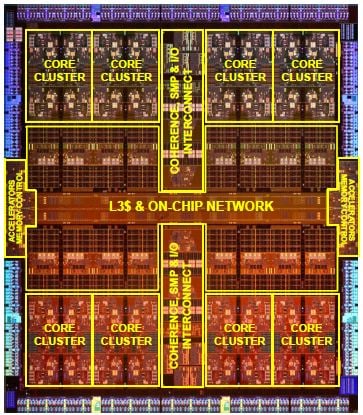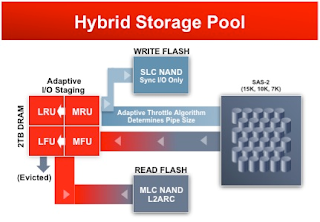 |
| [SPARC M7 Die, Courtesy The Register] |
Coming Soon: SPARC M7 and Solaris 12
Abstract:
Operating Systems and Software Vendors continue to struggle with the difference between 32 bit and 64 bit architectures, but the SPARC family of processors continues to roll out 64 bit CPU chips for data flagship Solaris 64 bit Operating System. Watching companies announce new products ahead of time is tricky because of Government Regulation, but sometimes watching less overt routes can provide a great level of insight as to what is coming soon. |
| [SPARC and Solaris Public Roadmap, courtesy Oracle Corporation] |
Roadmap: Foretelling the Future
Oracle has a history of releasing public road maps for SPARC and Solaris. They have been fairly accurate, since Oracle acquired Sun Microsystems. The roadmaps are subject to change, but they give the Architect a good idea of what is coming and how to plan for it. As of August of 2015, Oracle's public roadmap indicates that a new SPARC is in Test and Solaris 12 is coming early next year. The naming for that SPARC processor is not clear in the image, but |
| [System Controller and Console image, courtesy Oracle] |
Firmware: What's in the Wild
SPARC M7 is operational!
A recent firmware release indicates the following bug numbers have been resolved:
20246063 Kernel Zone panics on first boot on M7-8
20003379 New FRUID enums for 4S variants of M7-8 chassis
19336643 Internal error: Oops: 17 [#1] on M7-8 with SysFW build_33
The new SPARC M7, more than a dream, appears to be a reality. Understanding Oracle's naming conventions, the firmware notes indicates support for an 8 socket chassis. The Chassis and Processor clearly exists.
 |
| [Sun Microsystems Solaris Logo] |
Solaris 12 is running under OpenBoot!
A recent firmware release indicates the following bug numbers have been resolved:
Solaris 12 is apparently running on existing SPARC platforms at Oracle, which is a good sign!
 |
| [San Francisco Bridge & City, courtesy Oracle Corporation] |
JavaOne and OpenWorld 2015
The place to be will be Oracle OpenWorld in San Francisco, California during October 25-29.OpenWorld will offer many seminars to attend, but there is also JavaOne! Register & Fly to one of the most anticipated conferences of 2015. Why is this so anticipated?Seminars & Sessions at OpenWorld & JavaOne 2015
How big can you get? If you are struggling for performance: SPARC, Solaris, and Java can fix it.Operating a 16-Terabyte JVM...and Living to Tell the Tale [CON1855]Do you use Oracle RDBMS? It runs fastest in Oracle silicon, but WHAT silicon? M7 is a good bet!
Antoine CHAMBILLE, Global Head of Research and Development, Quartet Financial SystemsAmir Javanshir, Principal software engineer, OracleIs there a limit to the size of the heap the Java Virtual Machine can handle? Java blogs often report 100 GB as the maximum amount of memory the JVM can manage effortlessly. Yet Quartet FS develops ActivePivot, an in-memory analytic database written in pure Java that is frequently deployed in a terabyte of memory. In fact, earlier this year, it partnered with Oracle to deploy a large credit risk use case in 16 TB of memory and the 384 cores of an M6-32 SPARC server from Oracle. Yes, you can do it, once all the layers of the solution come together: data structures and thread management in the Java code, garbage collection in the JVM, memory management in the OS. This presentation shares all the steps to achieve this.Conference Session
Top 10 Tips and Tricks to Run Oracle Database Best on Oracle Solaris Systems [CON2742]Security: Solaris under SPARC M7 Processor making Buffer Overflows obsolete.
Ken Kutzer, Principal Product Manager, OracleViraj Nr, Principal Software Engineer, OracleOracle Engineering has focused on the codevelopment of Oracle Database, Oracle Solaris, microprocessors, and Oracle Storage Cloud, resulting in significant advantages for customers who deploy these products together. With each new release, deeper integration results in breakthrough enhancements in security, performance, and ease of management. This session outlines these enhanced capabilities and how they benefit you. Learn the top tips on how to optimize your configurations for the best-possible results. Areas covered include tuning tips for reliable performance and faster database startup with Oracle’s revolutionary new Software in Silicon database features.Conference Session
Learning to Use SPARC M7 Application Data Integrity to Detect Buffer Overflow Attacks [HOL5447]
Claude Teissedre, Market Development Engineer, OracleProgramming errors or input data checking inadequacies are vulnerabilities that can be exploited by attackers to alter the behavior of programs, and the “linear buffer overflow” attack remains a major threat to many applications today. Application Data Integrity (ADI), a Software in Silicon feature powered by Oracle’s SPARC M7 chips, allows the CPU to detect such memory corruptions at almost zero cost. This hands-on lab is primarily aimed at detecting simple attack patterns using the Oracle Solaris memory allocators and the Oracle Solaris Studio Discover ADI features. In this lab, advanced developers learn how to use the Application Data Integrity API to adapt a memory allocator to the ADI technology and to create a user and signal handler to customize the ADI error handling behavior.HOL (Hands-on Lab) Session
Database: More of Oracle RDBMS is executed in Silicon under Solaris with SPARC M7 Processor.
Speeding Up Oracle Database Using SPARC M7 Hardware Acceleration [HOL6011]Adina Kalin-florescu, ISVE engineer, OracleLing-yun Li, Principal Software Engineer, OracleWen-sheng Liu, OracleAngelo Rajadurai, Technology Lead Oracle System, OracleData Analytics Accelerator (DAX) is a Software in Silicon feature built into Oracle’s SPARC M7 chips. Eight DAX database offload engines are present on the SPARC M7 chip in addition to 32 cores. Many of the Oracle Database In-Memory 12c functions can run natively on the DAX, freeing the cores to do other work. Oracle has been integrating hardware and software together to give our customers the best platform for running Oracle Database. This lab looks at the advantage of Oracle Database In-Memory 12c on the SPARC M7 chip.HOL (Hands-on Lab) Session
Next Generation: What is coming on Oracle's Roadmap. Solaris 12 will probably be there.
General Session: Oracle Solaris Strategy, Engineering Insights, and Roadmap [GEN8606]Markus Flierl, Vice President, OracleThis session discusses the strategy and roadmap for Oracle Solaris. It covers how Oracle Solaris 11 is being deployed in cloud computing and the unique optimizations in Oracle Solaris 11 for the Oracle stack. The session also offers a sneak peek at the latest technology under development for Oracle Solaris and what customers can expect to see in the next major release. The speaker is joined by a key customer executive who shares the benefits and value experienced with Oracle Solaris and the business challenges solved.General Session
SPARC: Software in Silicon for Security and Speed. New SPARC design is probably M7.
General Session: Software in Silicon and SPARC Outlook—Secure, Smarter Database/Applications [GEN6421]The SPARC M7 appears to be a soon to be realized reality, with various discussions coming up in OpenWorld and Java One!Masood Heydari, SVP, Hardware Development, OracleSoftware-in-silicon technology is the most important development in enterprise computing of the decade, created by Oracle’s unique vision of breakthrough microprocessor and server designs through coengineering with the database, applications, and Java. This session will help you understand the advanced features that secure your application data with less effort, accelerate the performance of the Oracle Database In-Memory option of Oracle Database 12c, and run Java middleware in the most efficient and fastest-possible way. You will also understand Oracle’s strategy for creating the SPARC server technology that is changing the way customers look at their cloud infrastructure and IT system and will hear about the outlook for systems based on the new SPARC design Oracle has just unveiled.General Session
Conclusions:
Firmware being released on SPARC Servers are a clear indication of what is here. Oracle will be discussing the usage of SPARC M7 as a reality with live labs. If you are building Network Management platforms, this is the time to start your planning for hardware acquisition, to get the most "bang for the buck".










